Photographer Cody Brothers was born in Farmington, New Mexico. After attending West Point Academy and, later, exhibiting works at his first gallery showing in New York City, Brothers decided to devote his time to photography. Inspired by Dalí, Picasso, El Greco and Paul Strand, his work concentrates on abandoned farms, crumbling homes, neglected churches, aging cemeteries, forgotten cars and other objects, set within the vastness of the southwestern landscape, which he expresses as a narrative of “the western abandon.” He works almost entirely with infrared film, using a range of different cameras, including a 4 x 5, a hand-made pinhole, and a 6 x 17 panoramic. Shooting pictures in the early-morning or late-afternoon with a black-and-white infrared film is what he enjoys best because of the dreamy effect and the length of the exposure times required to get a great shot.
Cody captures his analog frames, then scans and renders each frame as a black-and-white digital chromogenic print. Each print is then typically finished in a more contemporary style: he mounts the large format digital print on an aluminum composite substrate that is sealed with a UV over-lamination, eliminating the constrictive feel of traditional framing, and accentuating the wide-open landscapes he captures.
There are few contemporary photographers who have the ability to transport a viewer to a particular location, and make that viewer feel as if they have known that exact place intimately. But Cody’s eye for location makes a two-dimensional black-and-white frame do exactly that.
The first thing that I notice when I see one of Cody’s works is the dramatic quality that each work achieves. In part, I believe that this comes from the particular way in which he is able to capture movement, especially cloud movement on film. That coupled with the camera choice and depth of field used to portray the vastness of landscape give his works a unique flair that is undeniably his own.
One of his recent projects, a labor of love that was completed over the course of the 2012 leap year, Through the Pinhole 366, provides viewers with an intimate look at Santa Fe and the surrounding landscape—as well as images of a few additional locations. Each image in the collection, complete with a description of what inspired the shot, is dated on the day the frame was captured.
April 24, 2012 depicts a single Joshua Tree from Joshua Tree National Park—but the tree is anything but lonesome looking. Cody recounts that this particular shot was taken while on vacation at the park—one of his favorite places. What drew Cody to this exact tree?
The “…shape of the tree, rocks, and low moving clouds…” he says. Using a modified “Zero Image” pinhole camera and SFX film, Cody transformed the mid-spring, late-morning atmosphere into a timeless image that may make viewers wonder what the place looked like during prehistoric times.
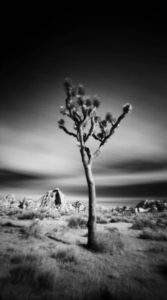
It’s “possibly my best shot from Joshua Tree,” he says. “I love the composition of the rocks, odd-looking tree, and clouds. I also love the movement and softness of the image; a result of the length of the exposure.”
Cody confesses that he’s always been a huge U2 fan and has always loved Joshua Trees, so this near-perfect frame definitely gave him what he was looking for that day!
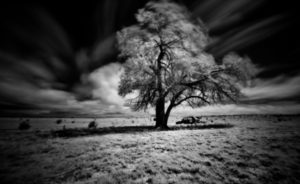
The shot that Cody captured with his pinhole camera near Milagro, New Mexico has a similar sweeping quality that appears in the sky. This image of a ranch with abandoned car, taken during a late-afternoon, early-fall photo journey off of I-40 Eastbound, provides viewers with a different feeling than the Joshua Tree image. Using the same modified “Zero Image” pinhole camera and SFX film, this frame feigns the feeling of gravity, pulling the viewer into the scene. Why was this car abandoned? Will it ever be retrieved by its owner? What is the curious story behind the auto?
Drawn to the old abandon car and the tree in combination with the great clouds, Cody says this shot is a “…great example of the effects of the modified infrared pinhole camera. The length of exposure shows movement, and gives a dream world effect.” And when asked about the mysterious appearance of the car, he confirmed: “The car is no longer there.”
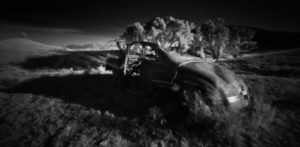
Similarly, the same questions could be raised about the abandoned car in the pinhole image shot near Elizabeth Town, New Mexico. On a return journey from Denver, Colorado, Cody was forced to take a back-road detour because of a wildfire at Raton Pass, and he stumbled upon this shot. Elizabeth Town, is a known haunted locale in Northeastern New Mexico.
In the past, Cody had seen this car and taken a couple of shots with a 4×5 camera, which showed the automobile from a different angle. This time, he used the same modified “Zero Image” pinhole camera and SFX film used in the earlier shots in the 366 project and he achieved a completely different effect.
“I love the perspective of the shot,” Cody says, “the location of car with the trees behind, and the one tree hill to the left.”
The late afternoon late-summer lighting creates a dramatic landscape and produces an eerie feeling despite the beautiful day. Viewers are almost fooled by the perspective into thinking that the tree-lined road leads somewhere off to the right beyond the image’s frame, but the horizon instead pulls the eye into the background to wonder: What lies beyond the hill?
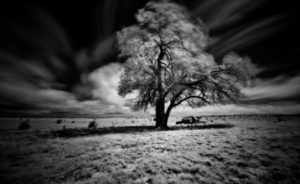
The pinhole project is just one of many for Cody, and of the 366 frames taken, each reveals a sense of place as well as a sense of time. How do these images manage to evoke a feeling of timelessness? the viewer can wonder. I think it’s the specificity with which each image is carefully chosen, framed, and shot, as well as the choice of perspective that Cody uses to portray these locations and their structures.
Images not part of the pinhole project share the ability to convey the vastness of the land, but evoke something completely different than the pinhole works. A panoramic image (shown here only as a detail) of buffalo grazing in Golondrinas, New Mexico was captured with a Fuji 6×17 GX carrying a 90mm lens, and using HP5 film.
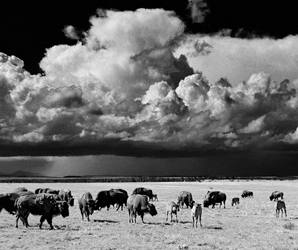 Cody took this shot on a hot summer day, alongside an imminent thunderstorm, which can be seen in the image’s background. He had driven by this location in the past, when the weather wasn’t good, and hadn’t seen any buffalo. But this shot was happenstance, as often photographic images are.
Cody took this shot on a hot summer day, alongside an imminent thunderstorm, which can be seen in the image’s background. He had driven by this location in the past, when the weather wasn’t good, and hadn’t seen any buffalo. But this shot was happenstance, as often photographic images are.
“I knew if the buffalo herd was there, with incoming storm clouds, the shot could be magical,” he says. “Besides the storm clouds and the buffalo, which make the shot, the date seems to have a significance with this image,” Cody says, referring to Independence Day. “Also, it seems to be a once in a lifetime shot. I’ve returned on several occasions, with no buffalo being present.” Panoramic images, he confirms, show a better peripheral view, and provide viewers with a closer representation of what the eye actually sees. The magnitude of this image, I think, isn’t fully captured unless in person.
The Chama House image evokes a similar experience in the viewer as the Golondrinas shot—an understanding of the West and the quintessential places that comprise it. In this frame, the weather is markedly different, and the house is nestled amongst desert brush, appearing to move in the wind. Cody captured this image as he traveled on Route 64, Northbound, just approaching Chama, New Mexico.
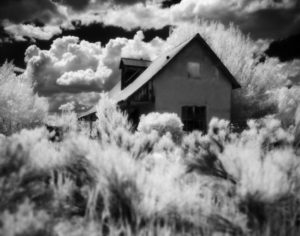 The abandoned house stood just off the highway, where Cody spotted it in route to Colorado. Taken with a 4×5 Wista Field Camera carrying a 150mm lens, he used Efke infrared film, which provides the high-contrast look shown here in the nearly black sky. The mid-summer, late-morning shot with great cloud coverage alongside the brush creates a unique use of depth of field. “The house appears to be floating in the clouds,” he says.
The abandoned house stood just off the highway, where Cody spotted it in route to Colorado. Taken with a 4×5 Wista Field Camera carrying a 150mm lens, he used Efke infrared film, which provides the high-contrast look shown here in the nearly black sky. The mid-summer, late-morning shot with great cloud coverage alongside the brush creates a unique use of depth of field. “The house appears to be floating in the clouds,” he says.
On another road trip to Moab, Utah, Cody stopped at Island in the Sky in Canyonlands National Park at the Hollbrook overlook. The panoramic image captured using a Fuji 6×17 GX carrying a 90mm lens was shot on Rollei R3 film.
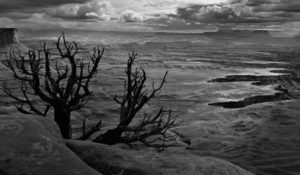 The detail shown here shows an early-spring, late-afternoon light that followed a day of rain and snow.
The detail shown here shows an early-spring, late-afternoon light that followed a day of rain and snow.
“I hadn’t gotten a shot all day, until this one,” Cody says. “This was my first visit to Canyonlands National Park, and I saw shot in the distance while driving. The sun came out for about 2 minutes, at most. I was lucky enough to be in the right place at the right time.” The panoramic was shot by hand, without the use of a tripod.
Although Cody often uses infrared film, even the images he captures on a regular black-and-white reel show high contrast, a stilling of movement, and a use of depth of field that draws the view in each and every time. It’s simultaneously the experience of being within and outside of the image itself.
When I look at these images, I see that what Cody renders, what he captures in a static frame, stilling life on film in black and white—and what I think other viewers may also come away with—is the sense, with irony, that nothing in life is black-and-white.
How did that abandoned car get there? Why was the house abandoned? Where are it’s owners? What is their story? Or: What narrative does the image evoke?
We can still for a moment the movement of the clouds, the breeze on a field, we can capture the deterioration of the material only to make us feel like we have found a way to transcend that which binds us to earth, which can be viewed through a lens, what we can capture on film, in “story.”
Perhaps even more extraordinary is the spectrum of grays that toggle between the blackest black and the whitest white—oh yes and it’s in those spaces that we return again to the comfort of uncertainty which allows each moment to be seen like a new composition, ready to be composed and captured on film.
When I asked Cody what he thinks when he hears the phrase Everything is Connected, he replied: “The Circle of Life.”
Cody Brothers currently resides in the village of Pecos, New Mexico. He and his wife Nikkol own and operate Visions Photo Lab in Santa Fe, which grants him the opportunity to offer custom photo services to the community, and also to personally perform every step needed to complete his work—from the initial processing of the film to the mounting and finishing of the final pieces.
Santa Fean residents and those traveling to the area can catch him in person at the historic El Dorado Hotel this July 27, where he will be part of the Art & City Lights Festival. Attendees can meet Cody, learn more about his work, see an exclusive slideshow of images, and even purchase a panoramic photo taken from the hotel rooftop.
If you don’t catch him at the El Dorado, you’ll have to track him down in route, at one of his dream expedition locations: Patagonia, Easter Island and the Galapagos, and Machu Pichu, or Africa, Italy, or China.
Cody Brothers is represented by Beals & Co., located in Santa Fe, New Mexico.